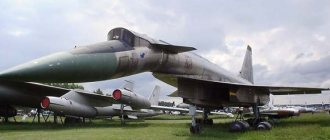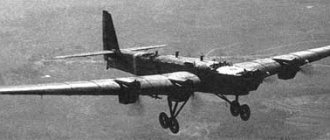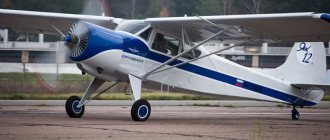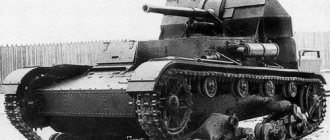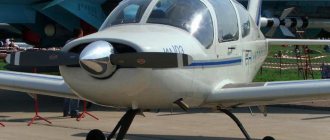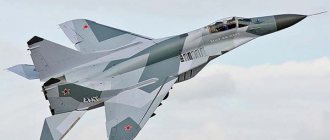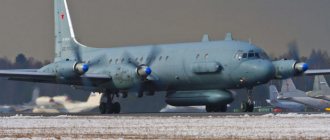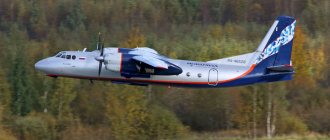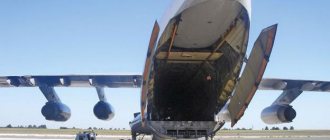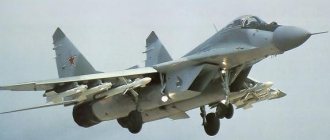The PE-2 bomber was created in 1938 and already made its first flight in 1939. Created on the basis of the twin-engine fighter “100” or “Sotok”, as it was called in wide circles, the aircraft was originally intended as a fighter for high-altitude flights. The creator of the bomber was V.M. Petlyakov. The history of its creation is interesting in that Petlyakov, who came under a wave of repression, was taken into custody as a pest, but due to the fact that the state did not want minds to disappear, a Special Technical Department was created on the basis of the NKVD - STO. This is actually where the name comes from.
Bomber PE-2. Photo.
“100” made its first flight on May 1, 1940. Everyone came to see this spectacle: ordinary citizens, soldiers, and officers of Germany, which at that time signed the “Non-Aggression Act” with the USSR. However, then the “weaving” was demonstrated as a high-altitude fighter, but already in June the purpose changed, and the aircraft was renamed PE-2 - a dive bomber.
The main task of the designers was diving: quite a lot of time was devoted to it, because this was to become the bomber's primary function. The crew of PE-2 or “Pawn” consisted of 3 people. The plane had two M-105 piston engines, each with a power of 1100 hp. The maximum speed of the aircraft was 540 km/h, the flight range was 1300 km. The service ceiling was 8800 m, and the maximum combat load was 1000 kg. The plane was completely covered with metal, only the steering wheel was made of fabric. The crew was protected by armor. The bomber had holes for machine guns.
But initially the PE-2 dropped bombs exclusively in a horizontal position, because the pilots were afraid that the wood chips would damage the plane and injure the crew. The first who was not afraid to dive was Ivan Semenovich Polbin. Its crew became the most friendly during the war. Three people, three friends, three comrades. They were inseparable: they flew together, rested together. This is how we went through the entire war, right up to Berlin. I.S. Polbin was twice awarded the title of Hero of the Soviet Union.
High-rise "weave"
The versatility of the Pe-2 was, one might say, hereditary. After all, this aircraft was originally designed as a high-altitude fighter escort for long-range bombers. The TB-7 long-range high-altitude bomber, better known under the designation Pe-8 and created by the efforts of the design bureau of the same Vladimir Petlyakov, was slated to play the role of his main charge.
Vladimir Petlyakov received the task to build a high-altitude fighter while an employee of the Special Technical Department of the NKVD. More precisely, allocated as part of the service station of the Central Design Bureau No. 29 - the famous Tupolev “sharashka”, which worked on Radio Street in Moscow, where he ended up in 1938. The new fighter received its index at the place of development: VI-STO, that is, a high-altitude fighter developed by the Special Technical Department. Such clarification was required because other aviation design bureaus that were not part of the STO were also working on the same topic, in particular, Deputy People's Commissar of the Aviation Industry Alexander Yakovlev and Pavel Sukhoi.
The success of Petlyakov’s machine in this race can be explained primarily by the fact that Petlyakov had enough experience in creating multi-engine aircraft, and a high-altitude fighter of that time could hardly have been single-engine. In addition, he needed a wing of sufficient elongation, which again gave an advantage in experience to the service station designers. Finally, both Yakovlev and Sukhoi were very busy at that time: the first was fine-tuning his Yak-1 fighter, the second was a plane named “Ivanov”, the future Su-2 short-range bomber. So Petlyakov overtook them in working on a high-altitude fighter.
The first flight prototype of the VI-STO, or VI-100, as the car began to be called, was built by the beginning of the winter of 1939, and on December 22 it took off from the ground for the first time. Despite the many comments received during the tests, the “weaving” made a very good impression on the pilots. They forgave her for the numerous defects identified during testing and continued to claim that this aircraft would be one of the best in the series. Members of the state commission, which in the spring of 1940 observed the tests of the “weaving” at the Air Force Research Institute, also agreed with this.
Although these flights generally ended in the death of the backup aircraft, the commission’s verdict turned out to be favorable. The first point in it represents the most successful solution to the issue of creating an armed vehicle with a sealed cabin. It is necessary to build a pilot series of aircraft “100”. But the third point of the conclusion forever changed the fate of the new aircraft. The State Commission noted that “in order to use the high aerodynamics of the 100 aircraft, it is advisable to create a dive bomber on its basis without a pressurized cabin. It is necessary to build a pilot series. The model of this aircraft must be submitted for approval by June 1, 1940.” Vladimir Petlyakov and his design team had only a month and a half left to complete this task.
Bomber PE-2. Video.
Only Petlyakov was not destined to see the success of his creation. The creator of the aircraft died in 1942, flying his PE-2. This happened not because of a malfunction in the plane, but because of the weather conditions, because it was winter, it was snowing, and the road was hard to see. But still V.I. Petlyakov will forever remain a great designer who played a winning game with his “Pawn”.
This aircraft was nicknamed “pawn” in the Soviet Army. The Pe-2 is a Soviet dive bomber that was actively used for combat purposes during World War II. It also became the most massive dive bomber made in the vastness of the Soviet Union.
History of Pe-2
The development of the “pawn” was carried out by designers and engineers of the NKVD Design Bureau, SKB-29 from mid-1938. It was designed on the basis of the high-altitude twin-engine experimental fighter “100”.
The first flight of the Pe-2 was made on December 22, 1939. Serial production of the aircraft began in 1940.
The Pe-2 was used as a flying laboratory to test rocket boosters. The first flight with a rocket launcher on board was possible in the fall of 1943; an increase in speed of 92 km/h was noted. Testing of various rocket launchers lasted until 1945. Rocket boosters were designed by S.P. Korolev.
Assembly and geometry
I see no point in comparing the model in terms of detail with the Moninsky Pawn of the 359th series, assembled from three target frames from the Krasnoarmeysky artillery range. There are practically no other complete “pawns” that have survived to this day in authentic condition - except for two models in Bugulma and Kazan, the crashed Pe-2 in Bodo (Norway) and the Pe-2 in the process of restoration in the Czech Republic (the plane flew on December 2, 1943 forced landing on the ice of Lake Koškajavr near Murmansk, sank in the spring and was raised from the lake in October 1996 with the help of an Mi-10K and sold to a private collector in Norway) only the late Pe-2 with the Gneiss-2 radar was preserved in the Museum of the Polish Army in Warsaw. But even after 60 years of standing in the open air, it is far from being in the best condition. I will evaluate the plausibility of the detailing already in the process of assembling the model, as well as the fit of the parts. Now, looking at the sprues, it is difficult to assess the geometry of the various small parts into which various components and assemblies were divided. I’m also not going to put the model into the drawings. Their quality and reliability are questionable. During the development of the model, its author carried out research work on the materiel and geometry of the Pe-2. The results of this work formed the basis of the model and you can read about them on the pages of the latest October issue of M-Hobby magazine. Let this be the case when the model may turn out to be more accurate than existing graphics in printed publications.
Pe-2 design
The design of the Pe-2 aircraft is made as a low-wing aircraft with a two-tail tail. It is worth noting the favorable location of the cockpit, from which the pilot and navigator had an excellent viewing angle. The speed reduction during a dive was carried out by lattice brake flaps, which were pressed against the lower part of the wing. Braking occurred by placing the flaps towards the flow.
For the first time in the USSR, this aircraft was equipped with many electrical control mechanisms. This step had to be taken because it would be difficult to remove the movable rods in the pressurized cabin. Unfortunately, it was the fly-by-wire equipment that often became the cause of spontaneous combustion of the apparatus in the air. Sparks that could form during operation ignited gasoline fumes.
An AMG-6 alcohol-glycerin mixture, which aviators called “chassis liquor,” was poured into the hydraulic system of a diving aircraft.
Advantages and disadvantages
At the time of the start of production, the Pe-2 had characteristics that were quite modern for that period. The speed of the bomber was not much lower than the German Messerschmitt Bf.109E (Emil) fighter of the 1940 model. The Pawn's competitor, the Junkers Ju.888A-4 manufactured in 1940, was larger and heavier. Despite the fact that the Junkers carried 3 tons of bombs, it was slower in speed (by about 80 km/h). The ceiling of the Junkers was 600 m lower. The Pawn was also superior to the Junkers in maneuverability.
The cockpit of the pilot and navigator was well equipped with instruments, the pilot was protected by an armored back, and then the navigator also received protection.
It should be noted that for an aircraft of such mass the bomb load is quite small. Of course, this is explained by the airframe's safety margin and weak engines, but this does not change the situation.
"Pawn" in camouflage color
Pe-2 operation
Military personnel were ambivalent about the appearance of this aircraft. On the one hand, the car was quite modern for those years and had excellent flight performance, good equipment and automation. On the other hand, it was difficult to control, especially when taking off or landing. The wing profile needed high speeds, and if you made mistakes in piloting at low speed, you could tip the plane onto its wing. On landing, the Pe-2 often felt awkward due to the poor performance of the landing gear shock absorbers, and on takeoff there was a tendency to turn around.
During braking for landing, the aircraft was prone to nosedown due to the specific location of the main landing gear.
The presence of an electric drive required competent maintenance, which was impossible to carry out efficiently in war conditions.
The birth of the ugly duckling
Soviet aircraft designers who worked in the USSR were in a very strange position. The most talented and promising aviation engineers ended up in 1937-38. into the millstone of political repression, serving time in camps and working as part of special design bureaus - sharashkin offices. It was there that future fighters were born, which became a threat to the German Luftwaffe; the VI-100, created at TsKB-29 under the leadership of V. M. Petlyakov, was to become just such an aircraft.
Bust of V. M. Petlyakov
Note: The experimental design bureau, called TsKB-29, was a specially created organization within the NKVD structure. Soviet aircraft designers and aviation engineers convicted in 1937-38 worked there. under Article 58. People called this organization sharaga, but it was here that the best Soviet bombers Pe-2 and Tu-2 were born, the first was created under the leadership of Petlyakov, the second belongs to the efforts of Andrei Tupolev.
Creating his fighter, V.M. Petlyakov was guided by the concept of dominance in the skies of heavy bombers that had developed in those years, which, as a result of massive air raids, would lead to the collapse of transport and logistics infrastructure. High-altitude fighters, capable of staying in the air for a long time and having superior weapons, had to resist such armadas.
VI-100
Despite the prospects of the development, the fate of the aircraft was affected by the assessment of the state of the air forces of countries that were considered as potential adversaries. Neither Germany, nor Japan, nor England or France had long-range bombers flying at high altitude at that time. Consequently, massive bombing at high altitudes was not considered as a tactic for using bomber aircraft. In this situation, there was no need for high-altitude fighters. It made sense to build fighters designed for maneuverable combat at low and medium altitudes.
The Petlyakovskaya “weaving”, equipped with two engines, looked too heavy for maneuverable air combat at close ranges. The car, like an ugly duckling, clearly stood out from the flock of new Soviet fighters.
It should be noted that the aircraft designer met such a verdict on his brainchild with understanding, especially since the senior military leadership of the Air Force did not intend to send the new development to the archives. The emphasis was placed on the high performance characteristics of the Petlyakov machine, which could be used to create a new short-range bomber based on the prototype. Originally created as a high-altitude fighter, hence the designation of the prototype VI-100 (high-altitude fighter), it was supposed to turn into a dive bomber. Only a month and a half was allotted to modernize the prototype and bring it into line with the tactical and technical requirements of a new class vehicle.
SB
In the Soviet Air Force, the main medium bomber at that time was the Tupolev machine - the SB high-speed bomber. Already during military operations during the Soviet-Finnish war of 1939-40. the machine clearly could not cope with its functions. Against this background, an urgent need arose for the appearance in service of the Soviet bomber aviation of a conceptually new vehicle capable of effectively supporting ground forces within the front. One of the options considered was the concept of creating a dive bomber. Petlyakov’s aircraft, in terms of its flight characteristics, was perfectly suited to this type of aircraft.
The idea of creating a dive bomber as the main front-line vehicle is not new. The concept of dive bombing, born overseas, was implemented in Germany. Here they managed to create the Yu-87, the best dive bomber at that time, and the tactics of escorting advancing ground forces with front-line aviation were born. Pre-war Germany even had its own school, which honed the elements of dive bombing and developed tactics for using dive bombers on the battlefield. The Germans, armed with the Yu-87, were the first to show the whole world in practice how successful the skillful use of dive bombers in the front line can be.
Junkers-87
Clear evidence of the superiority of dive bombers on the battlefield is the Polish campaign of 1939, the German invasion of France and the early years of the Great Patriotic War. Luftwaffe dive bombers literally hovered over the battlefield, performing precision bombing with surgical precision, replacing field artillery. This tactic was very popular with the Soviet military leadership, which always considered aviation as a strike force.
Combat use of Pe-2
The Pe-2 aircraft entered service with the USSR Air Force in 1941 and spent the entire period of World War II at the front. The bomber was used quite successfully for combat purposes. Due to the high speed of the Pe-2, it was good to use during daylight hours. But the first production bombers were equipped with weak defensive weapons. They were equipped with ShKAS machine guns - an extremely low-power and capricious weapon, the only advantage of which was its rate of fire.
Since this aircraft had to be covered in the air by fighters, it never reached its full potential during the war.
Only starting in 1943, production aircraft began to be equipped with Berezin machine guns instead of ShKAS, and the defensive power of the Pe-2 increased significantly.
The dive bomber was used for targeted strikes on enemy bases, transport hubs and ground vehicles in heavy cloud conditions, and was used to destroy enemy convoys.
Sotka changes its target
Although Vladimir Petlyakov’s design group was given only a month and a half to create a dive bomber from the Sotka, it coped with the task. So successful that on July 27, the designer was released from prison, and he was engaged in further development of his brainchild as a free man (the charges brought against him in the fall of 1937 would be completely dropped in 1953). And there was something to be said. Despite the fairly successful tests of the “hundred”, the car retained many “childhood diseases”. In addition to fighting them, Petlyakov had to simultaneously solve another problem: how to turn a high-tech and complex high-altitude fighter into a dive bomber that was as easy to operate and maintain as possible. The military did not hide the fact that they needed a machine that even yesterday’s schoolchildren who had completed an accelerated flight school course could handle.
First of all, we had to abandon the pressurized cabins with which the VI-100 was equipped. For a bomber operating at half the altitude, they were simply not needed, although the designer tried to preserve them. Next, the propulsion equipment was seriously changed. Two turbochargers pumping air were required at high altitudes, but at medium altitudes one regular one was enough. The third innovation - based on the results of tests, the "hundredth" changed the area and shape of the fins, the cockpit was moved forward, and the bottom of the nose of the aircraft was glazed to make approaching and aiming more convenient. They tried to preserve only the vehicle’s armament, which initially consisted of four ShKAS machine guns: one each for the navigator and radio operator, who defended the rear hemisphere, and two fixed course guns in the bow, for which the pilot was responsible.
In this modified form, the aircraft, which now had the index PB-100, that is, a “dive bomber,” entered state tests at the beginning of 1941. By this time, however, at Moscow plant No. 122, where the Ar-2 dive bombers had previously been assembled, the assembly of the Pe-2 was already in full swing (the machine received this index in December 1940). Such a strange sequence was dictated not only by the rush on the eve of the inevitable, as everyone already understood, war, but also by the usual practice for that time of starting mass production before the decision to accept the aircraft for service. And in March 1941, Vladimir Petlyakov was awarded the Stalin Prize for the creation of a new bomber.
Pe-2 characteristics:
| Modification | Pe-2 |
| Wingspan, m | 17.60 |
| Length, m | 12.60 |
| Height, m | 3.42 |
| Wing area, m2 | 40.50 |
| Weight, kg | |
| empty plane | 6200 |
| normal takeoff | 7775 |
| maximum takeoff | 8715 |
| engine's type | 2 PD M-105 |
| Power, hp | 2 x 1100 |
| Maximum speed, km/h | |
| on high | 540 |
| near the ground | 432 |
| Cruising speed, km/h | 412 |
| Practical range, km | 1500 |
| Maximum rate of climb, m/min | |
| Practical ceiling, m | 9000 |
| Crew | 3 |
| Weapons: | two bow 12.7 mm UBK machine guns and up to four |
| 7.62 mm ShKAS machine guns | |
| bomb load - normal - 500 kg, maximum - 1000 kg |
Aircraft
Engine nacelles and engines
It is proposed to make one of the engines open. For this purpose, the kit includes a sprue with an M-105PF engine from the Yak-3 kit. It is also possible to make the engine nacelles completely enclosed. There are no separate hoods for the open engine in the model. The quality of casting and detailing is excellent, but a resin engine will look more organic. The propeller blades, the ratchet on the spinner, the supercharger, the engine mount, the oil and water radiator screens, ventilation louvers and various pipelines - everything is done in the best possible way. The kit includes 2 types of exhaust pipes - separate for each cylinder (or 2 as middle pipes) or a common long pipe. This is a definite plus when building models of other series from aftermarket decals. The holes themselves in the pipes will need to be drilled. The propeller blades can be installed after painting into the propeller spinner, which simplifies the painting and assembly process.
Frontline bomber
OKB Petlyakov
Almost all WWII aircraft with liquid-cooled engines attempted to install a radial engine. And if on the LaGG-3 aircraft the installation of such an engine led to the creation of an outstanding fighter of the Second World War, then in the case of the Pe-2, as in most others, some improvement in the flight and technical qualities of the aircraft did not lead to the creation of a new aircraft.
In 1942, the M-105 engines, installed on the Pe-2, were also installed on the Yakovlev and LaGG-3 fighters, were in great short supply, and the difficulties of their supply forced the designers to look for the possibility of installing the Shvetsov M-82 then available on the Petlyakov aircraft , because in the first half of 1942 they were used only on the Su-2.
The expected increase in speed due to the installation of a more powerful engine (1100 hp for the M-105RA and 1330 for the M-82) was supposed to lead to an improvement in the aircraft's performance characteristics.
Leonid Leonidovich Selyakov, already mentioned in our article on the creation of the “Front Requirement” turret installation for the Pe-2FT aircraft, was appointed the lead designer for the creation of a new version of the aircraft.
The aircraft was created by converting one of the aircraft of the 31st series (No. 19/31), produced by the plant in 1931. In addition to replacing the engine mount (the M-105R with VISH-61 was replaced with an M-82 with AV-5L-118A propellers, covered with large rounded spinners with starter ratchets protruding forward), the bow ShKAS and onboard machine gun were removed from the radio operator's gunner, and an experimental turret was installed from the navigator's installation of VUB-2 with a BK machine gun.
The forward shift of the aircraft's alignment due to the installation of new, heavier engines forced the landing gear wheels to be moved forward, by 60 mm, by lengthening the struts. The empty plane turned out to be about 600 kg heavier.
The first prototype was ready at plant No. 22 in Kazan in the fall of 1942, but the plane, as they say, “didn’t work.” Despite the fact that at all altitudes the speeds increased, the practical ceiling increased and the take-off run decreased, the still low reliability of the Shvetsov engine of the early series negated all the advantages gained. During factory tests, oil was knocked out of the breathers, which ultimately led to engine seizure. The engine worked unreliably at idle, and stopping it for gliding during landing made it even more difficult and dangerous. Many problems were associated with the unsatisfactory functioning of the oil cooler; its gusts created a threat of oil leakage and engine seizure.
Long months of modifications and alterations delayed the release of the aircraft. Only in April 1943 did the plant deliver the aircraft for testing at the Air Force Research Institute; the test results at the Air Force Research Institute confirmed the factory test data.
If at the ground a plane with an M-82 was only 7 km (458 km/h versus 451 km/h) ahead of a machine with an M-105PF, released in February 1943, then already at medium altitudes the advantage increased significantly. Here, the new version of the Pe-2 overtook not only domestic aircraft with water-cooled engines, but also the American Douglas Boston III (A-20C), which at that time was one of the fastest serial medium bombers in the world. The Pe-2 with M-82 at an altitude of 6200 m developed a speed of 547 km/h, while the Boston III - 530 km/h at 4500 m. The new machine also significantly surpassed the Boston III in rate of climb and ceiling. During a combat turn, it was possible to reach 800 m instead of the previous 450-500 m. The high thrust of the engines sharply reduced the take-off run - from 620 m for a production aircraft with the M-105RA to 490 m (when boosting the M-82). The longitudinal and directional stability of the aircraft has improved somewhat. The new version flew freely on one engine.
However, the disadvantages were noted, perhaps, no less than the advantages. Bulky engine hoods impeded sideward visibility from the pilot's cockpit. But this was not the main thing: the reliability of the new power plant turned out to be very low; in operation it was complex, capricious and sometimes downright dangerous.
This combined with the lack of knowledge of the M-82 itself, errors in the design of the installation, and technological defects in a number of handicraft experimental units, for example, oil coolers. Formally, the service life of the M-82 produced by plant No. 19 was 100 hours, but the VG-12 spark plugs constantly failed. During tests at the Air Force Research Institute alone, 110 spark plugs were changed on one vehicle! The spark plugs failed every 5-6 hours of operation.
The afterburner control worked unsatisfactorily - it simply refused to turn off, and after all, the afterburner modes were very strictly limited in time. Otherwise, rapid engine failure is inevitable. The altitude corrector functioned poorly, oil coolers burst, and the mechanisms for opening and closing the front hood curtains failed. Vibrations were detected in some engine operating modes.
The Pe-2 had a high landing speed, and the heavy version with the M-82 landed at an even higher speed. Both landing at full throttle and gliding landing with the engines turned off were equally dangerous for the Pe-2 with its wing. Both options required great skill, inaccessible to the “precocious” wartime pilots. The new engines worked very poorly at idle - they regularly stalled, which made landing extremely dangerous.
And finally, there were a number of operational shortcomings. Mechanics complained that it was difficult to get to the oil tank drain valves. Due to the poor design of the engine nacelles, the engines took a very long time to warm up before takeoff. In winter, this procedure took up to 3-4 hours, which made the operational use of this aircraft impossible. The new engines were also more “gluttonous”, so the flight range compared to the version with the M-105RA dropped significantly.
Based on the results of tests at the Air Force Research Institute, aircraft No. 19/31 was considered unfinished. The plant was asked to eliminate the identified defects and produce a small series of aircraft with M-82 engines. In documents of that time, it was proposed to call the version of the Pe-2 with M-82 engines the Pe-4, but this name did not take root. Plant No. 22 assembled the first five Pe-2s with M-82 in August 1943. As in the case of reconnaissance and training aircraft, vehicles with M-82F engines were produced as if within 20 aircraft series in the form of separate “inclusions”. The first to be built was aircraft No. 1/226, then one or two aircraft were made in series 227 to 243, but series 244 was almost entirely equipped with Swedish engines. These aircraft featured all the new features that had appeared on production Pe-2s by that time, including a cockpit canopy with a radio antenna mast moved forward and an improved turret for the navigator.
A little earlier than on the series with the M-105PF, an extended top hatch appeared. The lack of ShKAS machine guns for the pilot and gunner remained unchanged, which was subsequently criticized in combat units. The bow ShKAS, for example, was often used for sighting. In the series, the engine nacelle bomb bays were restored. Myasishchev planned to continue work on improving the Pe-4 type by installing a new canopy with an FZ turret and moving the battery and oxygen cylinders further to the tail.
Myasishchev, in his August 1943 program, planned to continue work on improving the Pe-4 type by installing a new canopy with an F3 turret, changing the design of the middle section of the fuselage according to the Pe-2F type and increasing the internal bomb load. But this version of the vehicle, called Pe-4A, remained unrealized.
Of the 32 production Pe-2s with radial engines produced, only 24 were accepted for military acceptance. Despite such a small number of these vehicles, they appeared at the front and took part in combat operations.
The lead production aircraft Pe-2 with M-82F was tested at the Air Force Research Institute only in February 1944, and it was not No. 1/226 (its connecting rod broke during factory tests, and the aircraft failed), but aircraft No. 1/ 332. Due to the unsatisfactory performance of carburetors and altitude correctors, engines at altitudes above 3000-4000 m were not used at full power, so the maximum speed of the aircraft at the second altitude limit was less than at the first (526 km/h). There were two main reasons holding back serial production: a shortage of M-82F engines and the very low quality of oil coolers. It is still not entirely clear how the State Defense Committee could plan the mass production of “pawns” with Shvetsov engines, if there were not enough of them even for Lavochkin’s aircraft.
Moreover, a powerful competitor appeared - the A.N. Tupolev Tu-2 bomber. For the first time, several Tu-2s appeared at the front back in 1942 during military tests. On the Kursk Bulge there were only 18 Tu-2s in the 285th BAD of Colonel V.A. Sandalov, which were used mainly as scouts. And in May 1944, near Leningrad, the 334th battalion of Colonel N.P. Skokka consisted entirely of these aircraft. The Tu-2 was superior to the Pe-2 in terms of flight performance, armament, and bomb load.
In the spring of 1944, Pe-2M-82s began to be sent to combat units in small batches (3-5 aircraft each). For example, one of the squadrons of the 99th Guards Separate Reconnaissance Regiment had such aircraft. In the summer of 1944, the 39th ORAP received three vehicles. In these regiments, brake grilles were removed from aircraft.
There were Pe-2s with M-82s in regular bomber regiments, but they were also used mostly as reconnaissance aircraft. At the end of the war, the commander of the 4th Guards BAD, Hero of the Soviet Union, Major General F. Kotlyar, a famous master of aerial reconnaissance, flew such a machine.
It must be said that these cars were not liked at the front.
The reliability of new engines has not reached the level of old ones. There were complaints about unstable operation of the engines and difficult starting. Engines stalled from hypothermia at altitude, especially in winter. The introduction of new engines brought more trouble than benefit. Modifications of the Pe-2 with M-105PF and M-82 differed quite significantly in their components and assemblies, which created many difficulties in production and maintenance. The lack of development of the new engine unit did not allow full use of its advantages. The original reason for creating the modification also disappeared: the M-105 began to come in abundance from engine factories, and the M-82F found other mass “consumers” - the La-5 fighter and the Tu-2 bomber. There was no point in disrupting the well-established Pe-2 production process. Therefore, after the production of 32 serial machines with air-cooled motors, their production was stopped and they returned completely to the old motor installation. Instead of the Pe-2 with the M-82, Plant No. 22 received a new task - to restore production of the Pe-3, but with VK-105PF engines. Experimental Pe-2 aircraft
| Pe-2F | Pe-2A | Pe-2B | Pe-2M-82 | Pe-2M-1 | Tu-2 | ||
| Crew, people | 3 | 3 | 3 | 3 | 3 | 4 | |
| Date of testing | 5.1942 | 3.1944 | 6.1944 | 4.1943 | 2.1944 | 1943 | |
| Geometry | |||||||
| Aircraft length, m | 13.72 | 12.66 | 12.66 | 12.66 | 12.66 | 13.8 | |
| Wingspan, m | 17.13 | 17.13 | 17.13 | 17.13 | 17.13 | 18.86 | |
| Wing area, m² | 40.5 | 40.5 | 40.5 | 40.5 | 40.5 | 48.8 | |
| Weights, kg | |||||||
| empty | 6657 | 6035 | 6210 | 5485 | — | — | |
| normal | 8360 | 8320 | 8580 | 8525 | 8460 | 10360 | |
| Power point | |||||||
| Motor | M-105F | M-105PF | VK-105PF | M-82 | M-1F | AS-82FN | |
| Power, hp | near the ground | 2×860 | 2×950 | 2×1100 | 2×1100 | 2×1210 | 2×1850 |
| on high | 2×860 | 2×950 | 2×1100 | 2×1100 | 2×1210 | ||
| m | 4000 | 4100 | 5000 | 4800 | 3900 | ||
| Flight data | |||||||
| Maximum speed, km/h | near the ground | 468 | 466’/474» | 4472 | 494 | 474 | 482/509* |
| on high | 560 | 528’/537» | 534 | 547 | 562 | 547 | |
| m | 6500 | 3900 | 3900 | 5400 | 6000 | 5400 | |
| Practical ceiling, m | 10300 | — | 7500 | 9100 | — | 9500 | |
| Run length, m | 600 | — | 510 | 260 | — | — | |
| Armament | |||||||
| Strelkovoe | UB 12.7 mm | 3 | 3 | 3 | 3 | 3 | 2 |
| ShKAS 7.62 mm | 1 | 2 | 1 | 2 | 3 | ||
| Normal bomb load, kg | 600 | 600 | 600 | 400 | 600 | 1000 | |
' — After the first stage of improvements » — After the second stage of improvements * — During the 10-minute afterburner
Interior and detailing
The interior of the fuselage is richly finished. The entire visible power train is shown on the internal surfaces of the fuselage. Alas, there are traces of pushers on it. Apparently it was no longer possible to arrange them differently. The detailing of the cockpits is detailed and at the moment from the sprues it is difficult to compare with the real prototype. To do this, it must be assembled entirely. There is nothing to describe here, just look at the photos. The hatch into the cabin can be made open. Dashboards are available in two types – with decals and with relief. The interior is most clearly visible in the instructions. The set includes 3 crew figures, which are assembled from an average of 5 parts each. On the sprue with the engine from the Yak-3 there is also a spare fourth pilot figurine with two head options - with goggles on and goggles off. I'm not an expert in figures, but I quite liked them.
